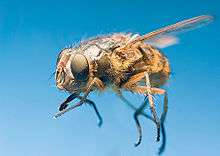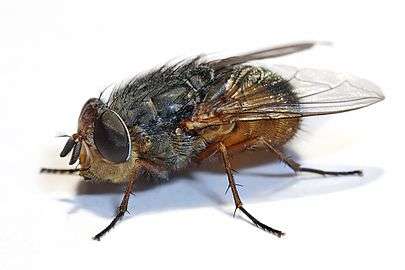Calliphoridae
The Calliphoridae (commonly known as blow flies, blow-flies, carrion flies, bluebottles, greenbottles, or cluster flies)[1] are a family of insects in the order Diptera, with 1,200 known species. The maggot larvae, often used as fishing bait, are known as gentles.[2] The family is known to be polyphyletic, but much remains disputed regarding proper treatment of the constituent taxa,[3] some of which are occasionally accorded family status (e.g., Bengaliidae and Helicoboscidae).
| Calliphoridae | |
|---|---|
 | |
| Male Chrysomya megacephala | |
| Scientific classification | |
| Kingdom: | Animalia |
| Phylum: | Arthropoda |
| Class: | Insecta |
| Order: | Diptera |
| Superfamily: | Oestroidea |
| Family: | Calliphoridae Brauer & Bergenstamm, 1889 |
| Subfamilies | |
| |
The name blow fly comes from an older English term for meat that had eggs laid on it, which was said to be fly blown. The first known association of the term "blow" with flies appears in the plays of William Shakespeare: Love's Labour's Lost, The Tempest, and Antony and Cleopatra.[4][5][1][6]
Description
Characteristics
Calliphoridae adults are commonly shiny with metallic colouring, often with blue, green, or black thoraces and abdomens. Antennae are three-segmented and aristate. The arista are plumose the entire length, and the second antennal segment is distinctly grooved. Members of Calliphoridae have branched Rs 2 veins, frontal sutures are present, and calypters are well developed.
The characteristics and arrangement of hairlike bristles are used to tell the difference between members of this family. All blow flies have bristles located on the meron. Having two notopleural bristles and a hindmost posthumeral bristle located lateral to presutural bristle are characteristics to look for when identifying this family.
The thorax has the continuous dorsal suture across the middle, along with well-defined posterior calli. The postscutellum is absent or weakly developed. The costa is unbroken and the subcosta is apparent on the insect.[7][8][9]
Development
Most species of blow flies studied thus far are anautogenous; a female requires a substantial amount of protein to develop mature eggs within her ovaries (about 800 µg per pair of ovaries in Phormia regina). The current theory is that females visit carrion both for protein and egg laying, but this remains to be proven. Blow fly eggs, usually yellowish or white in color, are about 1.5 mm × 0.4 mm, and, when laid, look like rice grains. While the female blow fly typically lays 150–200 eggs per batch, she is usually iteroparous, laying around 2,000 eggs during the course of her life. The sex ratio of blow fly eggs is usually 50:50, but one exception is females from two species of the genus Chrysomya (C. rufifacies and C. albiceps), which are either arrhenogenic (laying only male offspring) or thelygenic (laying only female offspring).
Hatching from an egg to the first larval stage takes about eight hours to one day. Larvae have three stages of development (instars); each stage is separated by a molting event. The instars are separable by examining the posterior spiracles, or openings to the breathing system.[10] The larvae use proteolytic enzymes in their excreta (as well as mechanical grinding by mouth hooks) to break down proteins on the livestock or corpse on which they are feeding. Blow flies are poikilothermic – the rate at which they grow and develop is highly dependent on temperature and species. Under room temperature (about 20 °C), the black blow fly Phormia regina can change from egg to pupa in 150–266 hours (six to 11 days). When the third larval stage is complete, it will leave the corpse and burrow into the ground to pupate, emerging as an adult seven to fourteen days later.
Food sources
Adult blow flies are occasional pollinators, being attracted to flowers with strong odors resembling rotting meat, such as the American pawpaw or dead horse arum. Little doubt remains that these flies use nectar as a source of carbohydrates to fuel flight, but just how and when this happens is unknown. One study showed the visual stimulus a blow fly receives from its compound eyes is responsible for causing its legs to extend from its flight position and allow it to land on any surface.[11]
Larvae of most species are scavengers of carrion and dung, and most likely constitute the majority of the maggots found in such material, although they are not uncommonly found in close association with other dipterous larvae from the families Sarcophagidae and Muscidae, and many other acalyptrate muscoid flies.
Predators
Predators of blow flies include: spiders,[12] beetles, frogs, and birds including chickens.
Diversity
About 1,100 species of blow flies are known, with 228 species in the Neotropics, and a large number of species in Africa and Southern Europe.
The typical habitats for blow flies are temperate to tropical areas that provide a layer of loose, damp soil and litter where larvae may thrive and pupate.
Genera
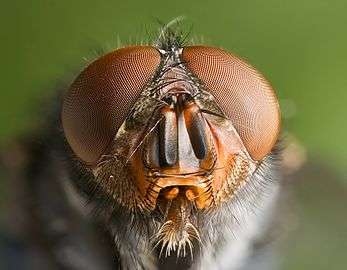
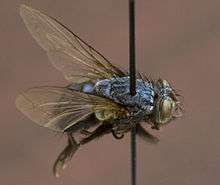
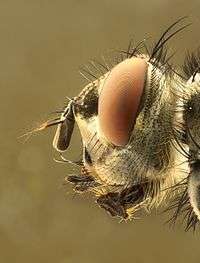
Sources: MYIA,[13] FE,[14] Nomina,[15] A/O DC[16]
This is a selected list of genera from the Palearctic, Nearctic, Malaysia (Japan) and Australasia:
- Abago Grunin, 1966[17]
- Amenia Robineau-Desvoidy, 1830
- Angioneura Brauer & Bergenstamm, 1893[18]
- Apaulina Hall, 1948[19]
- Cynomya Robineau-Desvoidy, 1830
- Aphyssura Hardy, 1940[20]
- Auchmeromyia Brauer & Bergenstamm, 1891[21]
- Bellardia Robineau-Desvoidy, 1863
- Bengalia Robineau-Desvoidy, 1830
- Booponus Aldrich, 1923[22]
- Boreellus Aldrich & Shannon, 1923
- Caiusa Surcouf, 1920[23]
- Calliphora Robineau-Desvoidy, 1830
- Callitroga Hall, 1948[19]
- Catapicephala Macquart, 1851[24]
- Chloroprocta Wulp, 1896
- Chrysomya Robineau-Desvoidy, 1830
- Cochliomyia Townsend, 1915[25]
- Compsomyiops Townsend, 1918[26]
- Cordylobia Gruenberg, 1903
- Cyanus Hall, 1948[19]
- Dexopollenia Townsend, 1917[27]
- Dyscritomyia Grimshaw, 1901[28]
- Eggisops Róndani, 1862
- Eucalliphora Townsend, 1908[29]
- Eumesembrinella Townsend, 1931[30]
- Eurychaeta Brauer & Bergenstamm, 1891[21]
- Euphumosia Malloch, 1926[31]
- Hemilucilia Brauer, 1895[32]
- Hemipyrellia Townsend, 1918[26]
- Lucilia Robineau-Desvoidy, 1830
- Melanodexia Williston, 1893[33]
- Melanomya Róndani, 1856
- Melinda Robineau-Desvoidy, 1830
- Mufetiella Villeneuve, 1933[34]
- Nesodexia Villeneuve, 1911[35]
- Neta Shannon, 1926[36]
- Onesia Robineau-Desvoidy, 1830
- Opsodexia Townsend, 1915[25]
- Pachychoeromyia Villeneuve, 1920[37]
- Paralucilia Brauer & Bergenstamm, 1891[21]
- Paramenia Brauer & Bergenstamm, 1889[38]
- Paraplatytropesa Crosskey, 1965[39]
- Phormia Robineau-Desvoidy, 1830
- Phumosia Robineau-Desvoidy, 1830
- Platytropesa Macquart, 1851[24]
- Polleniopsis Townsend, 1917[27]
- Prosthetosoma Silvestri, 1920[40]
- Protocalliphora Hough, 1899[41]
- Protophormia Townsend, 1908[29]
- Ptilonesia Bezzi, 1927[42]
- Rhynchoestrus Séguy, 1926[43]
- Sarconesia Bigot, 1857[44]
- Silbomyia Macquart, 1843[45]
- Stegosoma Loew, 1863[46]
- Stilbomyella Malloch, 1935[47]
- Toxotarsus Macquart, 1851[24]
- Triceratopyga Rohdendorf, 1931[48]
- Tricyclea Wulp, 1885[49]
- TricycleopsisVilleneuve, 1927[50]
- Trypocalliphora Peus, 1960[51]
- Xenocalliphora Malloch, 1924[52]
Economic importance
Myiasis
Blow flies have caught the interest of researchers in a variety of fields, although the large body of literature on calliphorids has been concentrated on solving the problem of myiasis in livestock. The sheep blow fly Lucilia cuprina causes the Australian sheep industry an estimated AU$170 million a year in losses.
The most common causes of myiasis in humans and animals are the three dipteran families Oestridae, Calliphoridae, and Sarcophagidae. Myiasis in humans is clinically categorized in six ways: dermal and subdermal, facial cavity, wound or traumatic, gastrointestinal, vaginal, and generalized. If found in humans, the dipteran larvae are usually in their first instar. The only treatment necessary is just to remove the maggots, and the patient heals naturally.[53] Whilst not strictly a myiasis species, the Congo floor maggot feeds on mammal blood, occasionally human.
Screwworms
The New World primary screwworm (Cochliomyia hominivorax), once a major pest in southern United States, has been eradicated from the United States, Mexico and Central America through an extensive release program by the USDA of sterilized males. The USDA maintains a sterile screwworm fly production plant and release program in the eastern half of the Republic of Panama to keep fertile screwworms from migrating north. Currently, this species is limited to lowland tropical countries in South America and some Caribbean islands.
The Old World primary screwworm (Chrysomya bezziana) is an obligate parasite of mammals. This fly is distributed throughout the Old World, including Southeast Asia, tropical and subtropical Africa, some countries in the Middle East, India, the Malay Peninsula, the Indonesian and Philippine Islands, and Papua New Guinea.[54]
The secondary screwworm (Cochliomyia macellaria) has become one of the principal species on which to base post-mortem interval estimations because its succession and occurrence on decomposing remains has been well defined. The secondary screwworm is found throughout the United States, the American tropics, and in southern Canada during summer months. This species is one of the most common species found on decomposing remains in the southern United States.[55]
Maggot therapy
Maggot debridement therapy (MDT) is the medical use of selected, laboratory-raised fly larvae for cleaning nonhealing wounds. Medicinal maggots perform debridement by selectively eating only dead tissue. Lucilia sericata (Phaenicia sericata), or the common green bottlefly, is the preferred species used in maggot therapy.[56] MDT can be used to treat pressure ulcers, diabetic foot wounds, venous stasis ulcers, and postsurgical wounds.[57]
Disease
Adults may be vectors of pathogens of diseases such as dysentery. Flies, most commonly Calliphoridae, have frequently been associated with disease transmission in humans and animals, as well as myiasis. Studies and research have linked Calliphora and Lucilia to vectors of causal agents of bacterial infections. These larvae, commonly seen on decaying bodies, feed on carrion while the adults can be necrophagous or vegetative. During the process of decay, microorganisms (e.g. Mycobacterium) may be released through the body. Flies arrive at the scene and lay their eggs. The larvae begin eating and breaking down the corpse, simultaneously ingesting these organisms which is the first step of one transmission route.[58]
The bacterium which causes paratuberculosis in cattle, pigs and birds (M. a. avium) has been isolated and recovered from these flies through several different experiments.[59]
Other potential and threatening diseases include rabbit haemorrhagic disease[60] in New Zealand and flystrike. Although strike is not limited to blow flies, these maggots are a major source of this skin invasion, causing lesions, which, if severe enough, may be lethal. Strike starts when blow flies lay eggs in a wound or fecal material present on the sheep. When the maggots hatch, they begin feeding on the sheep and thus irritating it. As soon as the first wave of maggots hatch, they attract more blow flies, causing the strike. Insecticides are available for blow fly prevention, and precautionary measures may be taken, such as docking tails, shearing, and keeping the sheep healthy overall.[61][62]
Salmonellosis has also been proven to be transmitted by the blow fly through saliva, feces and direct contact by the flies' tarsi. Adult flies may be able to spread pathogens via their sponging mouthparts, vomit, intestinal tract, sticky pads of their feet, or even their body or leg hairs.[63]
As the flies are vectors of many diseases, the importance of identifying the transmissible agents, the route of transmission, and prevention and treatments in the event of contact are becoming increasingly important. With the ability to lay hundreds of eggs in a lifetime and the presence of thousands of larvae at a time in such close proximity, the potential for transmission is high, especially at ideal temperatures.
Forensic importance
Blow flies are usually the first insects to come in contact with carrion because they have the ability to smell dead animal matter from up to 2 kilometres (1 mile) away.[64] Upon reaching the carrion, females deposit eggs on it. Since development is highly predictable if the ambient temperature is known, blow flies are considered a valuable tool in forensic science. Blow flies are used forensically to estimate the PMImin (minimum post-mortem interval) for human corpses.[65] Traditional estimations of time since death are generally unreliable after 72 hours and often entomologists are the only officials capable of generating an accurate approximate time interval. The specialized discipline related to this practice is known as forensic entomology.[66]
In addition to being used to estimate the minimum post-mortem interval (PMImin), assuming colonization occurred after death, blow fly specimens found infesting a human corpse are used to determine if the corpse was relocated or if the individual ingested narcotics prior to death.
Calliphora vicina and Cynomya mortuorum are important flies of forensic entomology. Other forensically important Calliphoridae are Phormia regina, Calliphora vomitoria, Calliphora livida, Lucilia cuprina, Lucilia sericata, Lucilia illustris, Chrysomya rufifacies, Chrysomya megacephala, Cochliomyia macellaria, and Protophormia terraenovae. One myth states that species from the genus Lucilia can sense death and show up right before it even occurs.[4]
References
- "Calliphoridae". Integrated Taxonomic Information System. Retrieved 31 May 2008.
- "Gentle". Oxford Dictionaries. Retrieved 24 May 2016.
- Yeates, D. K.; Wiegmann, B. M. (1999). "Congruence and controversy: toward a higher-level phylogeny of Diptera" (PDF). Annual Review of Entomology. 44: 397–428. doi:10.1146/annurev.ento.44.1.397. PMID 15012378.
- Brundage, Adrienne (13–15 February 2008). "Calliphoridae". Texas A&M University, College Station. Cite journal requires
|journal=(help) - UniProt. "Calliphoridae". Retrieved 31 May 2008.
- Whitworth, Terry (July 2006). "Keys to the Genera and Species of blow Flies (Diptera: Calliphoridae) of America North of Mexico" (PDF). Proceedings of the Entomological Society of Washington. 108 (3): 689–725.
- Anne Hastings, David Yeates & Joanna Hamilton (2004). "Anatomical Atlas of Flies". CSIRO. Archived from the original on 18 January 2012. Retrieved 13 January 2012.
- "Biological Sciences: Northern Kentucky University". Nku.edu. 14 January 2013. Retrieved 29 May 2014.
- "INSECTES15-4". Aramel.free.fr. Retrieved 29 May 2014.
- "diaporama image". Archived from the original on 27 December 2004. Retrieved 11 March 2014.
- Goodman, Lesley J. (1964). "The landing responses of insects. II. The electrical response of the compound eye of the fly, Lucilia sericata, upon stimluation by moving objects and slow changes of light intensity" (PDF). Journal of Experimental Biology. 41 (2): 403–415.
- Welch, John B. (1993). "Predation by Spiders on Ground-Released Screwworm Flies, Cochliomyia hominivorax (Diptera: Calliphoridae) in a Mountainous Area of Southern Mexico". Journal of Arachnology. 21 (1): 23–28. JSTOR 3705375.
- Sabrosky, Curtis W. (1999). "Family-Group Names in Diptera An annotated catalog" (PDF). MYIA, the International Journal of the North American Dipterists' Society. 10. Archived from the original (PDF) on 11 April 2008.
- Rognes, Knut; Pape, Thomas (19 April 2007). "Taxon details: Calliphoridae". Fauna Europaea version 1.1. Retrieved 31 May 2008.
- "Diptera: B–C". Nomina – a classification of the Insects of North America as portrayed in Nomina Insecta Nearctica. 1998. Archived from the original on 6 May 2006. Retrieved 31 May 2008.
- Kurahshi, Hiromu (28 May 2007). "109. Family CALLIPHORIDAE". Australasian/Oceanian Diptera Catalog. Retrieved 31 May 2008.
- Grunin, K. Ya. (1966). "New and little-known Calliphoridae (Diptera), mainly bloodsucking or subcutaneous parasites of birds". Ent. Obozr (in Russian). 45: 897–903.
- Brauer, F.; Bergenstamm, J. E. von (1893). Die Zweiflugler des Kaiserlichen Museums zu Wien, VI. Vorarbeiten zu einer Monographie der Muscaria Schizometopa (exclusive Anthomyidae). Pars III. F. Tempsky, Wien. p. 152.
- Hall, D. G. (1948). The blowflies of North America. Thomas Say Publ. p. 4.
- Hardy, G. H. (1940). "Notes on Australian Muscoidea". Proceedings of the Royal Society of Queensland. 51: 133–146.
- Brauer, F.; Bergenstamm, J. E. von (1891). "Die Zweiflugler des Kaiserlichen Museums zu Wien. V. Vorarbeiten zu einer Monographie der Muscaria Schizometopa (exclusive Anthomyidae)". F. Tempsky, Wien: 142.
- Aldrich, J. M. (1923). "A new genus and species of fly reared from the hoof of the carabao". The Philippine Journal of Science. 22: 141–142.
- "Revision of the frog fly genus Caiusa Surcouf, 1920 (Diptera, Calliphoridae), with a note on the identity of Plinthomyia emimelania Rondani, 1875" (PDF). zootaxa. Retrieved 26 May 2016.
- Macquart, P. J. M. (1851). "Dipteres exotiques nouveaux ou peu connus. Suite du 4e supplement publie dans les memoires de 1849". Mem. Soc. R. Sci. Agric. Lille. 1850: 134–294.
- Townsend, C. H. T. (1915). "A new generic name for the screw-worm fly". Journal of the Washington Academy of Sciences. 5: 644–646.
- Townsend, C. H. T. (1918). "New muscoid genera, species anProposal of new muscoid generad synonymy (Diptera)". Insecutor Inscit. Menstr. 6: 151–156.
- Townsend, C. H. T. (1917). "Indian flies of the subfamily Rhiniinae". Rec. Indian Mus. 13: 185–202. doi:10.5962/bhl.part.5859.
- Grimshaw, P. H. (1901). "Part I. Diptera". Fauna Hawaiiensis. 3 (1): 1–77.
- Townsend, C. H. T. (1908). "The taxonomy of the muscoidean flies, including descriptions of new genera and species". Smithson. Misc. Collect. 51: 138 pp. Archived from the original on 16 February 2015. Retrieved 22 November 2014.
- Townsend, C. H. T. (1931). "Notes on American oestromuscoid types". Rev. Ent. (Rio J.). 1: 65–104.
- Malloch, J.R. (1926). "Exotic Muscaridae (Diptera).--XVIII". The Annals and Magazine of Natural History. 9 (17): 489–510. doi:10.1080/00222932608633438.
- Brauer, F. (1895). "Bemerkungen zu einigen neuen Gattungen der Muscarien und Deutung einiger Original-Exemplare". Sber. Akad. Wiss. Wien. 104 (Abt. I): 582–604.
- Williston, S. W. (1893). "List of Diptera of the Death Valley Expedition". N. Am. Fauna. 7: 235–268.
- Villeneuve, J. (1933). "Myodaires superieurs asiatiques nouveaux". Bull. Ann. Soc. R. Ent. Belg. 73: 195–199.
- Villeneuve, J. (1911). "Dipterologische Sammelreise nack Korsika. (Dipt.) [Schluss] Tachinidae". Deutsche Entomologische Zeitschrift. 1911: 117–130.
- Shannon, Raymond Corbett (1926). "Synopsis of the American Calliphoridae (Diptera)". Proceedings of the Entomological Society of Washington. 28: 115–139. Retrieved 5 June 2020.
- Villeneuve, J. (1920). "A propos de la revision de Muscidae testaceae de J. Surcouf". Bulletin de la Société Entomologique de France. 1920: 223–225.
- Brauer, F.; Bergenstamm, J. E. von (1889). "Die Zweiflugler des Kaiserlichen Museums zu Wien. IV. Vorarbeiten zu einer Monographie der Muscaria Schizometopa (exclusive Anthomyidae).Pars I". Denkschriften der Kaiserlichen Akademie der Wissenschaften. 56 (1): 69–180. Retrieved 25 November 2014.
- Crosskey, R. W. (1965). "A systematic revision of the Ameniinae (Diptera: Calliphoridae)". Bulletin of the British Museum (Natural History), Entomology. 16: 33–140. doi:10.5962/bhl.part.21863.
- Silvestri, F. (1920). "Contribuzione alla conoscenza dei termitidi e termitofilidell' Africa occidentale. II. - Termitofili. Parte seconda". Boll.Lab. Portici. 14: 265–319.
- Hough, G. de N. (1899). "Some North American genera of the dipterous group, Calliphorinae Girschner". Entomological News. 10: 62–66.
- Bezzi, Mario (1927). "Some Calliphoridae (Diptera) from the South Pacific islands and Australia". Bulletin of Entomological Research. 17 (3): 231–247. doi:10.1017/s0007485300019283.
- Séguy, Eugène (1926). "Sur une forme nouvelle se rapportant aux "Oestridae dubiosae"". Encyclopedia Ent. (B II). 3: 1–10.
- Bigot, J. M. F. (1857). "Dipteres nouveaux provenant du Chili". Annales de la Société Entomologique de France. 3 (5): 277–308.
- Macquart, P. J. M. (1843). "Dipteres exotiques nouveaux ou peu connus". Mem. Soc. R. Sci. Agric. Lille. 2 (3): 162–460.
- Loew, H. (1863). "Enumeratio Dipterorum quae C. Tollin ex Africa meridionali (Orangestaat, Bloemfontein)". Wien. Ent. Monatschr. 7: 9–16.
- Malloch, J.R. (1935). "The Diptera of the Territory of New Guinea. III. Families Musicidae and Tachinidae". Proceedings of the Linnean Society of New South Wales. 60: 74–78.
- Rohdendorf, B. B. (1931). "Calliphorinen-Studien IV (Dipt.). Eine neue Calliphorinen-Gattung aus Ostsibirien". Zoologischer Anzeiger. 95: 175–177.
- Wulp, F. M. van der (1885). "Quelques dipteres exotiques". 28. Bulletin & Annales de la Société Entomologique de Belgique: cclxxxviii–ccxcvii. Cite journal requires
|journal=(help) - Villeneuve, J. (1927). "Myodaires superieurs nouveaux de l'Œle de Formose". Revue Zool. Bot. Afr. 15: 387–397.
- Tuomikoski, R. (1960). "The Ocydromiinae group of subfamilies (Diptera, Empididae)". Ann. Entomol. Fenn. 32: 282–294.
- Malloch, J.R. (1924). "The recorded Calliphoridae of New Zealand (Diptera)". Proceedings of the Linnean Society of New South Wales. 55: 638–640.
- Yazdi, Ismail. "Oral mucosa myiasis caused by Oestrus Ovis". Archives of Iranian Medicine. Retrieved 17 April 2008.
- Sutherst, R. W.; Spradbery, J. P.; Maywald, G. F. (1989). "The potential geographical distribution of the Old World screwworm fly, Chrysomya bezziana". Med. Vet. Entomol. 3 (3): 273–280. doi:10.1111/j.1365-2915.1989.tb00228.x. PMID 2519672.
- Byrd, Jason H. "Secondary Screwworms". Featured Creatures Jan 1998 1–2. Archived from the original on 10 March 2008. Retrieved 28 March 2008.
- Monaghan, Peter (1 June 2007). "Rx:Maggots, Notes from Academe". The Chronicle of Higher Education. 53 (39): A48.
- Sherman, R. (September 2006). "Maggot Therapy Project". Maggot Therapy. Retrieved 28 March 2008.
- EBSCOhost. 1 April 2008
- EBSCOhost. 4 April 2008
- EBSCOhost. 2 April 2008
- "NOAH Compendium of Animal Medicines: Crovect 1.25% w/v Pour-on Solution for Sheep - Dosage and administration". Archived from the original on 19 October 2013. Retrieved 11 March 2014.
- Peacock, Andrew (31 August 2004). "Blow fly in Sheep" (PDF). Newfoundland and Labrador Agriculture. Archived from the original (PDF) on 17 December 2008. Retrieved 15 April 2008.
- Olsen, Alan R. (1998). "Regulatory Action Criteria for Filth and Other Extraneous Materials*1 III. Review of Flies and Foodborne Enteric Disease". Regulatory Toxicology and Pharmacology (Submitted manuscript). 28 (3): 199–211. doi:10.1006/rtph.1998.1271. PMID 10049791.
- Joel Greenberg (2004). "Many more than we know: insects". A Natural History of the Chicago Region. University of Chicago Press. pp. 291–316. ISBN 978-0-226-30649-0.
- Klong-klaew, Tunwadee; Ngoen-klan, Ratchadawan; Moophayak, Kittikhun; Sukontason, Kom; Irvine, Kim; Tomberlin, Jeffery; Kurahashi, Hiromu; Chareonviriyaphap, Theeraphap; Somboon, Pradya (December 2018). "Spatial Distribution of Forensically Significant Blow Flies in Subfamily Luciliinae (Diptera: Calliphoridae), Chiang Mai Province, Northern Thailand: Observations and Modeling Using GIS". Insects. 9 (4): 181. doi:10.3390/insects9040181. PMC 6315425. PMID 30513924.
- Stephen W. Bullington (24 July 2001). "Blow flies: their life cycle and where to look for the various stages". Forensic Entomology. Archived from the original on 13 October 2006. Retrieved 13 January 2012.
Identification
- Fritz Konrad Ernst Zumpt Calliphorinae, in Lindner, E. Fliegen Palaearkt. Reg. 64i, 140 p. (1956)
- Fan, C. T. Key to the common synanthropic flies of China. Peking [= Beijing]. xv + 330 p. In Chinese but really excellent illustrations. (1965).
- Kano, R. and Shinonaga, S. Calliphoridae (Insecta: Diptera) (Fauna Japonica), Tokyo Biogeographical Society of Japan, Tokyo.( 1968). In English.
- Lehrer, A. Z., Diptera. Familia Calliphoridae. In: Fauna R.S.R., Insecta, vol. XI,(12), Edit. R.S.R., Bucuresti, 1972, 245 p. In Romanian.
- Rognes, K. Blowflies (Diptera: Calliphoridae) of Fennoscandia and Denmark. Fauna Entomologica Scandinavica, Volume 24. E. J. Brill/Scandinavian Science Press Ltd. Leiden.(1991).
External links


- Image Gallery
- Examples of maggot therapy (dead link 28.2.2017)
- Secondary screwworm on the University of Florida / Institute of Food and Agricultural Sciences Featured Creatures website
